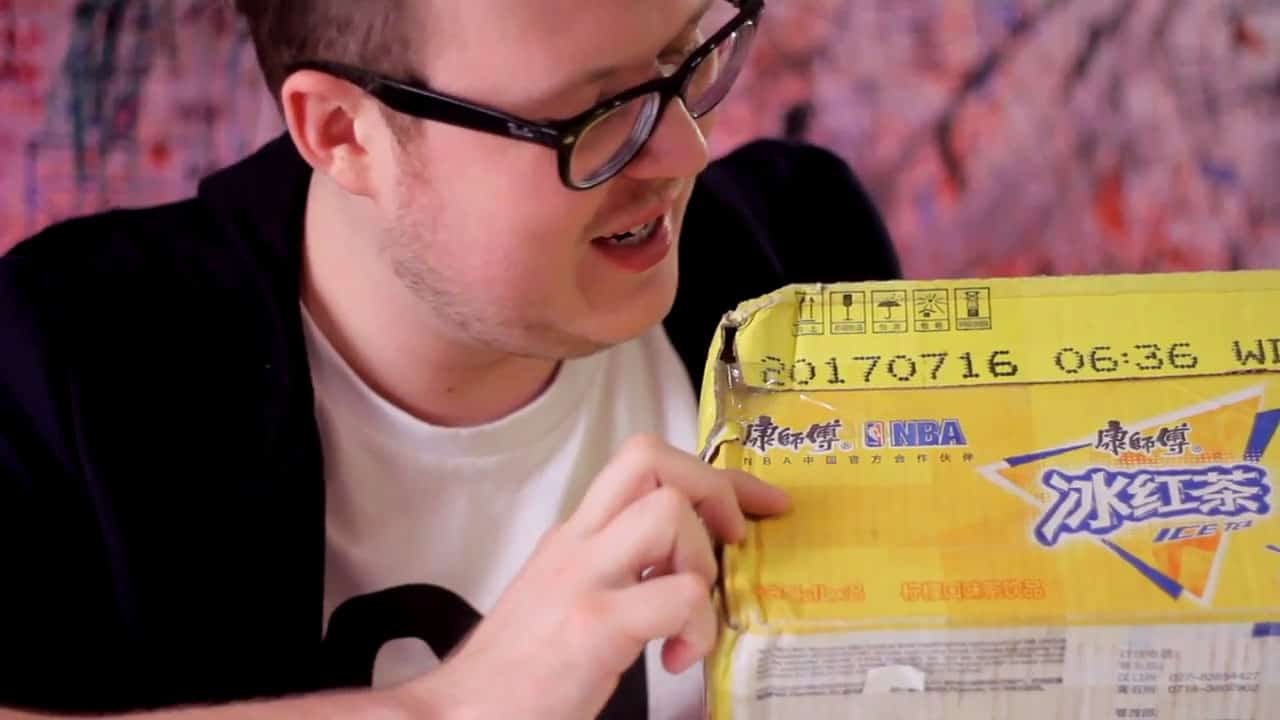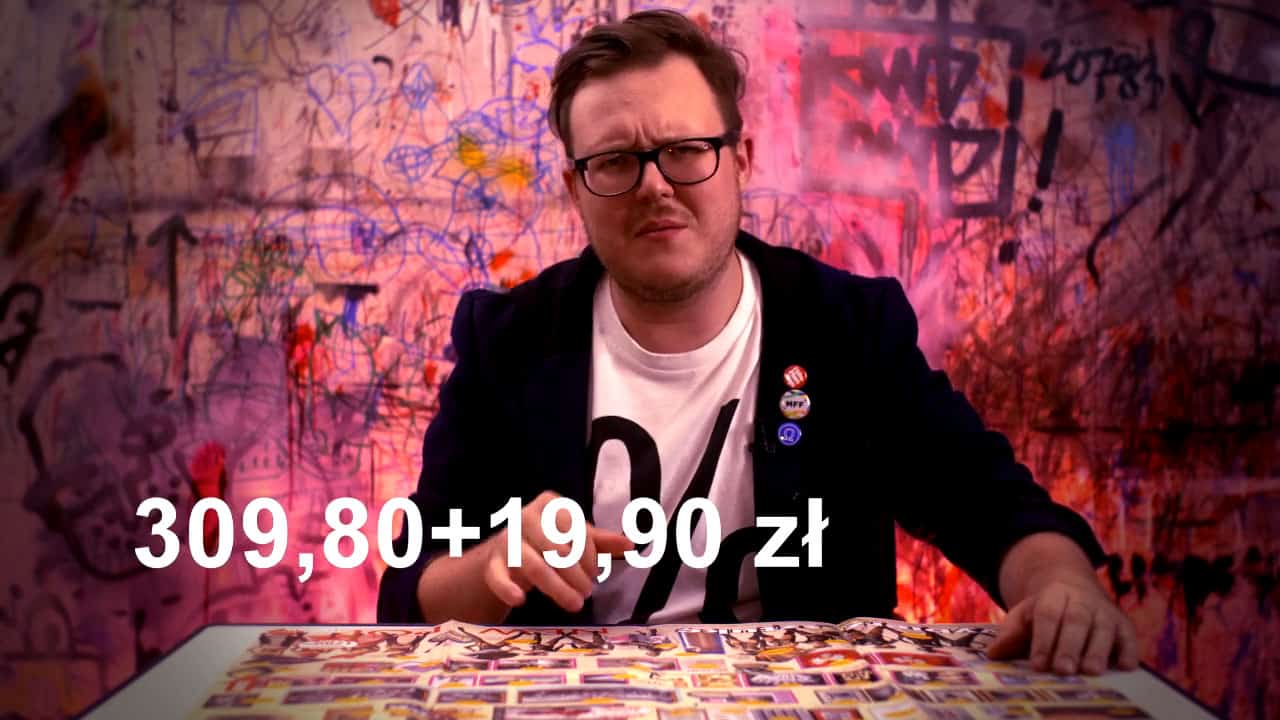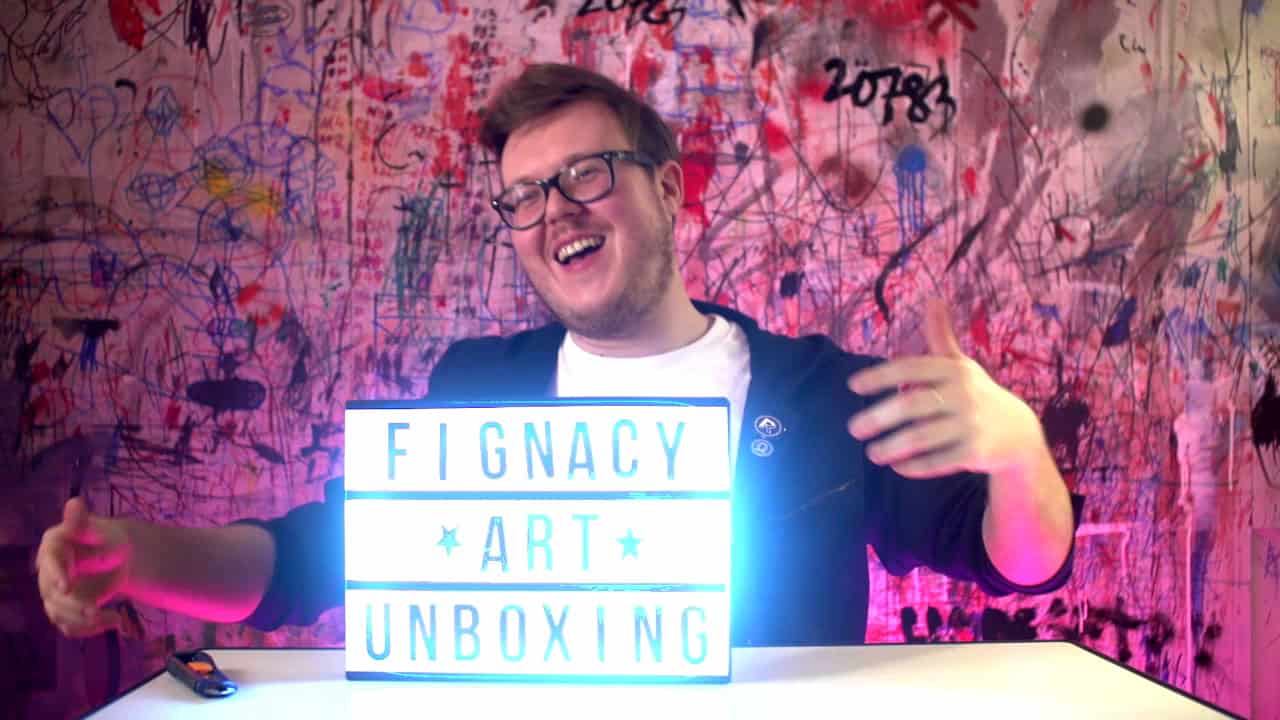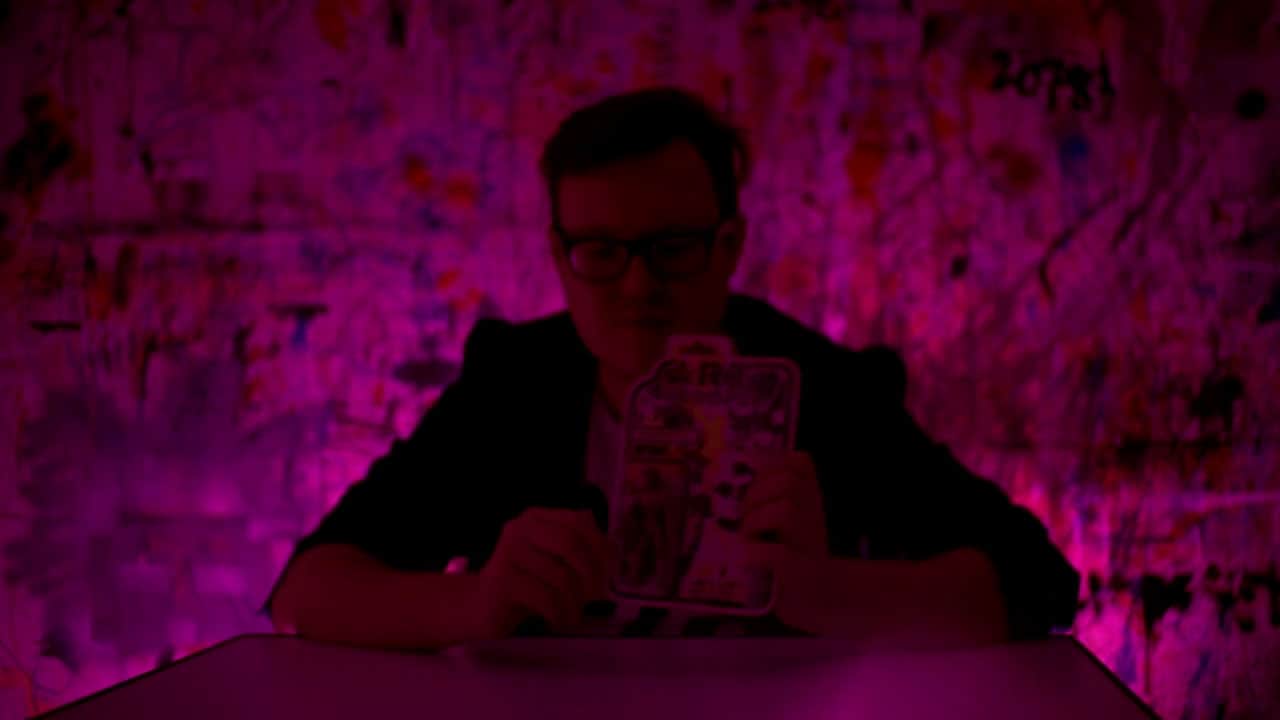The first of June marked the opening of an online exhibition which brings the atmosphere of performance and YouTube culture closer to the audience. Every Monday at 6 p.m. until the 3rd of August a new episode from the artUNBOXING series featuring Filip Ignatowicz is launched by ŁAŹNIA Centre for Contemporary Art. I had a brilliant opportunity to have an online conversation (so the mode of interaction was basically the same as between the performer and the audience in artUNBOXING episodes) with the artist whom we see in all episodes, who happened to be in the middle of editing the latest episode to be streamed. This became the starting point for our talk.

#artUNBOXING, ŁAŹNIA Centre for Contemporary Art
VZ: I just wanted to tell you that editing the episodes is a great process. I even waited to read the credits because I wanted to know who was making all the editing work.
FI: This is so nice to hear. I do it all myself. The whole process of editing is an integral part of my work, maybe even the most important one. The only script I have is actually the topic I selected. Later on, it goes along with what comes to my mind as I speak. This, however, does not mean that I do everything randomly. I choose objects which are easy for me to speak about and which fit the collection, help me communicate a message important to the society or refer to certain phenomena in culture that I find interesting. The stage of cutting and editing is when my episodes are actually created. It is only at this stage that I know what I am going to keep out of my monologue. At this moment I also decide which other works I am going to quote. The whole process resembles a big movie production, since my work is created three times – at the stage of finding an idea, filming and editing – each time the work may be slightly different than it seemed before.
VZ: Where did such a unique idea come from?
FI: The whole artUNBOXING idea came to me quite naturally. For a long time, I have been interested in the relationship between culture and consumption, the way that art and consumer goods combine. These are topics which are present in many of my works. When I unbox art, I ironically put it at the same level as an object or a commodity, I show that consumption is omnipresent. I also do all this since I am following the principle of egalitarianism to some extent and want to make art accessible, democratic and take it off a pedestal. I want to give everybody who has access to the Internet the chance to participate in this experience. I want to increase the striking power of art. I would like art not to be so exclusive. In my opinion, this exclusive nature of art is sometimes mistakenly considered a good thing or luxury. I dream of art that is, or should be, a value which is inclusive in the first place. Going back to the beginnings of this project, I also knew a thing or two about the strategies of using fakes, making dummies and pretending.

#artUNBOXING, ŁAŹNIA Centre for Contemporary Art
VZ: What was the ultimate incentive to carry this project out?
FI: What finally convinced me to go ahead with artUNBOXING was an event from the history of art which inspired me at some point. Robert Rauschenberg, when he was still a young artist, exchanged a bottle of whiskey for a drawing with Willem de Kooning, who was a prominent painter at that time. Later on, Rauschenberg painstakingly rubbed the drawing out until the time when all that was left was paper with no traces of any drawing tool being used and no gesture. This very piece of paper was framed and exhibited. The title of this piece was “Rubbed out drawing by Willem de Kooning” and Robert Rauschenberg was listed as the author. This artistic takeover and quoting of a work by another artist is what I do in my episodes as well. My way of thinking was probably inspired by what I just told, however there are no aspects of destroying someone else’s work in artUNBOXING episodes. I was fascinated by the whole trend of unboxing videomaking, which originated thanks to Internet users spontaneously. I combined it with my inspirations and experience and I have the feeling that the artUNBOXING series is what just had to come out of this mixture and that there was no way it would come along differently.
The first episode was shot ages ago, namely in November 2015. Afterwards I created the first series which became a part of an exhibition connected with my PhD thesis entitled “ART BAZAAR”, which I defended in 2018. Nonetheless, I continued to wait for a good moment to start and I did not even know whether it would come. I always knew that I wanted to launch the project, I collected materials I would unbox in front of the audience but there was no stimulus to go live. It was only when the COVID-19 pandemic led to the lockdown, quarantine, isolation and closure of art galleries, theatres and cinemas that I felt the urge to start the project right then and take the process seriously, as non-serious as it is in fact. Instantly there was a huge gap when it comes to access to art. Obviously, art was available online, for example exhibitions were documented on museum websites and theatre plays were streamed, and this was all great, however, not in the long run, because such works were never intended to be presented to the audience using electronic devices. In contrast, artUNBOXING was intended to be a YouTube project from the very beginning. The exhibition of Łaźnia Centre for Contemporary Art was launched and this is the first occasion for my works to be presented so extensively to such a big audience. The exhibition was a response to the need and an attempt to fill the empty space which had not been taken over. Kinga Jarocka, the curator I turned to with my project, was really engaged and thanks to her efforts and amazing work of the whole Łaźnia PR team we managed to select 10 episodes to be presented as part of the #artUNBOXING exhibition and to initiate the process of creating a community and the audience to follow the project.

#artUNBOXING, ŁAŹNIA Centre for Contemporary Art
VZ: I have an impression that you were influenced by the unboxing videos which we can now easily find on YouTube, maybe in order to make ironic references to them. I have to admit that I watched one episode in the subway and a man standing next to me asked me “Who is this youtuber?”. When I heard this question, I had the feeling that art already became a mainstream thing.
FI: I am fascinated with the phenomenon of substitution and the unboxing videos are a wonder, they are now produced on an enormous scale. It is very likely that the combined number of views of all iPhone unboxing videos is larger than the number of iPhones ever produced. This is why we can easily draw a conclusion that there are people in the world who watch such videos in order to derive some kind of consumer pleasure out of the viewing experience. They behave as if they were not able to be consumers but wanted to feel the glitter and immerse themselves in consumerism, so that they still remain members of society. After all, people who do not consume goods are in some way excluded from society. It is a bit as if they were window shopping accompanied by the performer or a presenter who experiences the unboxed object and describes it.
When it comes to the mainstream and art, I have the feeling that sometimes it is the other way round. Unfortunately, mainstream is so strong that it becomes art or it covers art and takes it over. Based on the definition of art we choose, the online activities of many Internet users, such as short YouTube videos, can now be considered creative activities, sometimes even artistic activities. It is true that art easily absorbs what is new and fresh in the world.
VZ: Do you use the links between everyday life and fine arts?
FI: I like working “under the cover”, pretending and using the attention of my viewer who may not be aware that what he sees is a work of art. I acted following this approach many times when I put my works in supermarkets and other shops. On one occasion, several dozens of my fake DVD recordings were sold. It was supposed to be Christmas carols sung by celebrities, but in fact it was a found footage remix of Christmas-themed advertisements presenting the consumerist nature of celebrating this holiday. On another occasion I left the chair I made in the IKEA exposition. It stood there with a forged label for over 8 hours until the moment when someone wanted to buy it. I sometimes brought my own cheese-flavoured crisps to shops as affirmation of wonder and Kinder Surprise eggs with small artworks inside instead of toys. I painted pictures on canvas in the size of real chocolate bars, crisp packets and sweets and exhibited them in a vending machine, and my audience mistakenly took it for a real vending machine full of delicious treats. In reality, the insides included nothing else as nearly five hundred small pictures. Irony and humour are often the basic means of artistic expression for me, so if someone asked you who this youtuber was while watching my video over your shoulder then I am delighted, because it means that I reached my goal, I deceived someone. I used the visual language of unboxing, which is the cover in this form of artistic expression. I created a hidden work of art which may entice someone into getting to know the world of high culture and helps me popularize artistic activities as such. I am really ecstatic about what you said, this is one of the best compliments possible for a project of this kind!

#artUNBOXING, ŁAŹNIA Centre for Contemporary Art
VZ: The first episode of artUNBOXING is about the figurine of Andy Warhol, which was made by the artist called RYCA. This episode is as metamodernist as it might have possibly been. We watch an artist looking at a figurine of another artist made by yet another artist. Do you think that the whole world of contemporary art is a Matryoshka with a metamodernist face?
FI: Indeed, it is a bit like that. I even said something about it in the episode, I said that it certainly was a tautology, something on a meta level. I am fascinated and slightly amused with the fact that such a legend and classic as Andy Warhol throughout his life wanted to show that a simple product can be a work of art and that, at the very end, he became a product himself. I am sure he would be glad that things turned out this way and I do not think that this has any pejorative connotations. Perhaps this is a metamodernist Matryoshka, I have to admit that this comparison is extremely beautiful and visually captivating. I would love to unbox such metamodernist Matryoshka for real in one of my episodes! I have the feeling that the phenomenon you asked about can be easily explained by quoting the conclusions regarding the consumer society which are often drawn nowadays. According to Zygmunt Bauman, consumer society is characterised by the rules of the market, marketing and economy penetrating into interpersonal relationships and even into the relationship each of us has with our own selves. These rules sort of define and program us. We become similar to the world in which we function, we are what we eat. Consequently, if consumption is omnipresent and we are bombarded with new offers and goods, we become consumer goods ourselves. Self-commoditization is another term coined by Zygmunt Bauman and I often use it when I talk about my projects.
Nowadays we are our own biggest commodity and product, and we advertise it everywhere and to everyone trying to sell it to as many people as possible. Willy-nilly, we do it every day in a lot of settings – at school, while writing a CV and looking for a job, introducing ourselves to strangers and setting up an account on Instagram. Some people do not notice that we are, in fact, wrapped up or packed in a box. I can see my own private box and try to use it. I certainly laugh at this box and make fun of it. I talk about consumption because I am a typical HOMO CONSUMENS, so I am a commodity and a seller at the same time. This is why, while having this conversation with you, I try to sell and advertise myself as well as I possibly can. I give it my best shot to present the context for my activities, introduce myself to a wider audience – this is pure self-commoditization! Through a particular gesture, which marked the final of my MA education at the Faculty of Painting of my Alma Mater, I transformed myself from a young artist into a brand, a name. I ceased to just be Filip Ignatowicz and became FIGNACY&co. I packed all my paintings into boxes and hung them just like in a shop, I also created 1:1 images of myself and wrapped them up as well, just like we do with toys.

#artUNBOXING, ŁAŹNIA Centre for Contemporary Art
VZ: How do you imagine the future of art?
FI: This is an extremely difficult question. I really believe in my intuition, but I never possessed any prophetic powers, so my first answer would be: “No idea!”. The only thing we can say for sure is that there will be more memes presented online. If I were to give a serious answer, I would say that art, just like people, has an enormous power to adapt itself. I have the impression that recent months proved how powerful culture is. If there was no culture, what else would we have been doing locked down in our homes? Suddenly a lot of people realized that culture is what gives meaning to our existence. So, whatever is ahead of us, art will adapt to it. If the second lockdown comes, more culture would need to be transferred to online reality, but I think it will be much more than posting pictures of artworks on the websites. I expect it to be projects focused on the online language from the very beginning, which will specifically target the community of Internet users. I am really happy that online activities are no longer discredited. Earlier on only the exhibitions “in the real world” were acknowledged with material artworks hanging in a gallery which was a real building. I also got into this trap and thought about culture exclusively in this way. Nowadays this is changing and artistic activities can sensibly benefit from the opportunities offered by Internet and virtual reality. In my opinion there will be a wider offer of such cultural events in the future.
Maybe there will be more people like Bob Ross whose retro show was made available online a few years ago and turned out to be a hit, a meme and a viral at the same time. Maybe there will be more apps like the one which allows downloading works by KAWS or Olafur Eliasson on the phone and look at them in augmented reality. It is possible that artists will create mini narrations in a form of Instagram filters, just like David OReilly does or will move to TikTok to present their performances. It seems now, judging from the posts published on Twitter, that Jan Hakon Erichsen is really active on TikTok where he gracefully destroys balloons and pasta.

#artUNBOXING, ŁAŹNIA Centre for Contemporary Art
VZ: Are you going to continue your artUNBOXING project?
FI: I am going to be active and see how this project evolves. Working on this project is something new for me, something that excites me constantly. At the beginning it even made me go out of my comfort zone, but, after all, this is what it is all about. I do not want to get stuck in a rut and unboxing works of art provides me with a lot of stimuli. The form itself provides room for experimentation and alteration. I am working on a number of episodes which will resemble vlogs and even Let’s Play. My YouTube performances will certainly not end at the moment the exhibition organized by ŁAŹNIA Centre for Contemporary Art is closed. I am obviously looking for other galleries and culture institutions which would be willing to present artUNBOXING in a virtual reality and so far, I am ready to release a new episode every Monday at 6 p.m. We will see how much episodes I will be able to make, but as for now, I have a lot of fun with it and I am willing to carry on. At the same time, I try to attract as many followers as possible, so let me now be a genuine YouTuber and ask the readers of this interview to find me on Instagram and YouTube, to like my videos and subscribe to my channel. Last but not least, I would like to express my gratitude to everyone who helped me during my work on realizing this crazy idea – to partner institutions, my PhD thesis supervisor, my curator, the artists who let me use their works, my friends and relatives. Although this is my personal project, there are credits at the end of each episode which make you realise how many people I cooperated with to make the episode reach you.

#artUNBOXING, ŁAŹNIA Centre for Contemporary Art








